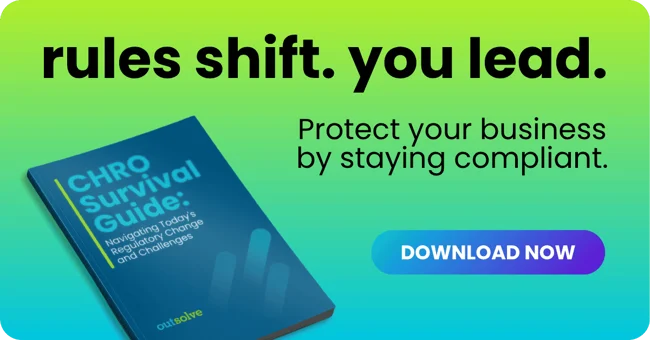5 min read
CHRO Survival Guide: The Hidden Costs of Deregulation and the Rise of AI in HR Compliance
![]() OutSolve
:
Nov 12, 2025 2:24:55 PM
OutSolve
:
Nov 12, 2025 2:24:55 PM

In Part 1 of our CHRO Survival Guide series, we examined the regulatory “whiplash” caused by a surge of Executive Orders in 2025 and the uncertainty they’ve created for HR leaders. Part 2 of OutSolve’s 3-part research report, we shift focus to the hidden costs of deregulation and how policy rollbacks often increase, rather than decrease, internal complexity.
From costly rewrites and retraining to stricter I-9 and E-Verify enforcement, HR teams face a heavier compliance workload than ever. At the same time, the rise of AI in HR systems introduces both opportunities and risks, demanding careful oversight to avoid bias and maintain employee trust.
The Hidden Costs of Deregulation (for businesses)
The Trump administration’s stated goal is to free business from excessive regulation. But paradoxically, employers may experience higher compliance costs from this movement. Policy changes often create a cascade of internal adjustments, re-training, and cross-functional coordination that were not necessary in more stable times.
Internal Overhead, Additional Training and Policy Rewrites
Rolling back a federal requirement doesn’t erase internal processes, software configurations, or contractual obligations that reference it. Every EO-driven change triggers legal review, procedural rewrites, and retraining, often across multiple departments. For large organizations, this can mean dozens of policy documents and training modules need updating.
For example, when E-Verify rules were tightened in early 2025 to include enhanced document validation protocols, employers who had integrated the prior E-Verify standard into applicant tracking systems now had to recode software, retrain HR staff, and update vendor contracts. Again, even when the public narrative from regulators is one of simplification, the ambiguity and confusion caused by recent directives can stall hiring, frustrate managers, and create internal friction between HR and IT.
Additionally, the training implications are substantial. HR teams that were previously trained on federal contractor affirmative action requirements now need to understand which elements remain applicable under different circumstances. New hires in HR roles need comprehensive training on both current and recently changed requirements. Organizations may find that their existing HR policy training programs are obsolete, requiring redevelopment of educational materials and procedures.
Stricter I-9 and E-Verify Enforcement
While some diversity-related obligations have been removed and federal equal opportunity audits paused, Form I-9 enforcement is on the rise. As has been reported by many publications including Reed Smith’s Law Watch, ICE activity has intensified versus previous years. During the first half of 2025, ICE has significantly increased Notices of Inspection (NOIs) and workplace audits, with penalties for paperwork violations now reaching $2,701 per occurrence and $28,619 for substantive violations such as knowingly employing unauthorized workers. Even unintentional errors — like transposed dates or missing signatures — can add up quickly when multiplied across hundreds of employee records. Download our I-9 research report titled I-9 Compliance Trends: Enforcement Risks and Best Practices for more information on the new immigration landscape and what it means for employers.
As observed by employment law firm Ballard Spahr, E-Verify compliance checks have become more frequent, especially for federal contractors. The U.S. Citizenship and Immigration Services (USCIS) monitors E-Verify usage and provides detailed information on account compliance. USCIS also checks whether employers are correctly handling tentative nonconfirmations (TNCs) and documenting the resolution process; possibly referring a case to ICE. Subsequently, ICE can review E-Verify case records during a Form I-9 inspection to determine if TNCs are handled properly.
Pay Equity and Transparency
Pay equity compliance illustrates another dimension of this complexity. Under EO 14173, federal contractors are no longer required to evaluate compensation systems to determine whether there are gender-, race-, or ethnicity-based disparities. But equal pay liability under pay equity and nondiscrimination laws still exists, including at the state level. Colorado, California, New York, and Washington, for example, all have robust pay transparency and equity requirements. Companies with multi-state operations must now manage a patchwork of different requirements. Download our State Pay Transparency Guide to stay on top of the changing regulations.
Some deregulation at the federal level is being offset by state and local laws expanding pay equity and transparency requirements. But the patchwork nature of these laws means CHROs must track and apply multiple standards. This task is even harder when remote workers live in different jurisdictions. Is it the law where the employer is located that applies, or where the remote employee lives that applies?
Actions for CHROs and Compliance Leaders
- Conduct a compliance gap analysis across all of your organization’s processes and initiatives to identify procedural impacts caused by EO-related rollbacks.
- Centralize documentation protocols to meet overlapping federal, state, and local requirements.
- Establish a cross-functional “policy transition team” including HR, Legal, IT, and Compliance to accelerate procedural rewrites.
- Invest in targeted compliance training for HR and recruiting staff on updated I-9, E-Verify, and pay transparency rules.
- Leverage compliance technology. Adopt hosted application services that stay current with regulatory changes. This will reduce administrative overhead, increasing accuracy and completeness of the data collected.
Managing Increased Demand for Data and the Implications of AI
If deregulation is the political disruptor of 2025, AI is the technological disruptor. According to recent observations by SHRM, CHROs are facing unprecedented demands for data integration — and unprecedented scrutiny over how that data is used. Artificial Intelligence has jumped from pilot-project to production in recruiting, mobility, L&D, and employee support. Surveys show rapid adoption by HR (e.g., SHRM notes the share of orgs using AI in HR climbed markedly into 2025), which in turn creates big demands for data integration across ATS, HRIS, payroll, LMS, and collaboration tools.
In response, regulators have sharpened expectations for automated decision-making. Examples include the EEOC’s Title VII guidance on AI/adverse impact, the NYC AEDT Law (bias audits + notices), Texas HB 149, and the Colorado AI Act.
AI in Talent Management
Modern AI-enabled HR platforms can now parse resumes, assess video interviews for verbal and non-verbal cues, recommend promotions, and forecast attrition risks. Vendors tout efficiencies, but EEOC guidance warns that algorithmic decision-making must be monitored for bias. A poorly designed algorithm can unintentionally replicate, or even amplify, historical biases in hiring and promotions.
For example, Amazon famously scrapped an AI recruiting tool after discovering it systematically downgraded resumes from women for technical roles. This is a cautionary tale that remains relevant today as AI becomes more embedded. Today’s systems may be more sophisticated, but without transparent logic and human oversight, similar risks remain.
Regulatory Catch-Up
Federal agencies have yet to fully regulate AI in HR decision-making, or in any other arena. In fact, America’s AI Action, published by the Whitehouse, is decidedly deregulatory. But state-level AI transparency bills are gaining traction. Colorado’s SB 21-169 restricts unfair discrimination in algorithmic decision-making, requiring notice to affected individuals. Similar bills are in consideration by New York, California and other states. This signals that compliance complexity will grow even without federal action.
As mentioned above, the EEOC has made it clear that AI-powered hiring tools are subject to existing anti-discrimination laws. If an algorithm produces disparate impact against protected groups, the employer is still liable regardless of whether that bias was intentional. This means companies need to regularly audit their AI tools. It also means companies must maintain detailed documentation of algorithmic decision-making processes and be prepared to demonstrate that their AI systems don't discriminate against protected classes.
Actions for CHROs and Compliance Leaders
- Audit AI tools for bias after deployment and at regular intervals. Maintain documentation of testing protocols and remediation steps.
- Require human-in-the-loop review for high-impact decisions such as hiring and promotion.
- Create an AI ethics policy that addresses transparency, employee data privacy, and appeal processes.
- Educate managers about AI capabilities and limitations so they can interpret recommendations critically.
- Be transparent about the use of AI in employment-related processes; where it’s used and how its algorithms are programmed.
Conclusion
Despite promises of simplification, deregulation has left CHROs with higher compliance costs, complex patchworks of state and federal rules, and heightened risks around workforce data and immigration enforcement. Layered on top of this is the accelerating adoption of AI in HR, a powerful tool that, without safeguards, can amplify bias and create legal exposure.
As we’ve seen in Part 2, today’s HR leaders must not only adapt to new compliance demands but also build the frameworks to responsibly manage emerging technologies.
In Part 3 of our series, we’ll turn to the human side of HR leadership: the challenges of talent acquisition, employee retention, and reconciling corporate culture with shifting regulatory directives. We’ll explore how CHROs can maintain organizational values while navigating a turbulent policy and talent landscape.
Related Resources
- CHRO Survival Guide: How CHROs Can Navigate the Regulatory Rollercoaster
- CHRO Survival Guide: The Hidden Costs of Deregulation and the Rise of AI in HR Compliance
OutSolve commissioned this research report to educate and inform employers and clients of dramatic change in the human resources landscape. By analyzing the latest regulatory shifts, emerging compliance risks, and technological disruptions facing HR leaders, this report provides actionable insights and practical strategies tailored for both federal contractors and private sector organizations. Our goal is to equip HR teams with the knowledge they need to navigate new challenges, remain compliant, and sustain high-performing, values-driven workplaces in the face of today’s uncertainty.
Founded in 1998, OutSolve has evolved into a premier compliance-driven HR advisory firm, leveraging deep expertise to simplify complex regulatory landscapes for businesses of all sizes. With a comprehensive suite of solutions encompassing HR compliance, workforce analytics, and risk mitigation consulting, OutSolve empowers organizations to navigate the intricate world of employment regulations with confidence.
Weekly OutLook
Featured Posts

The Federal Government Shutdown Lingers: HR Professionals Take Action

HR Planning: 5 Planning Steps for Q4
Related Posts

CHRO Survival Guide: The Hidden Costs of Deregulation and the Rise of AI in HR Compliance
In Part 1 of our CHRO Survival Guide series, we examined the regulatory “whiplash” caused by a surge of Executive Orders in 2025 and the uncertainty...

Reduce Risk, Not Resources: Why I-9 Verification Should Be Outsourced
Immigration enforcement is back in the spotlight, with employers squarely in the crosshairs. With a growing, large budget for DHS and a renewed focus...

Breaking Down the Notice of Inspection for ICE Audits
Getting a Notice of Inspection (NOI) from U.S. Immigration and Customs Enforcement (ICE) can make any HR professional nervous. While it may seem...




